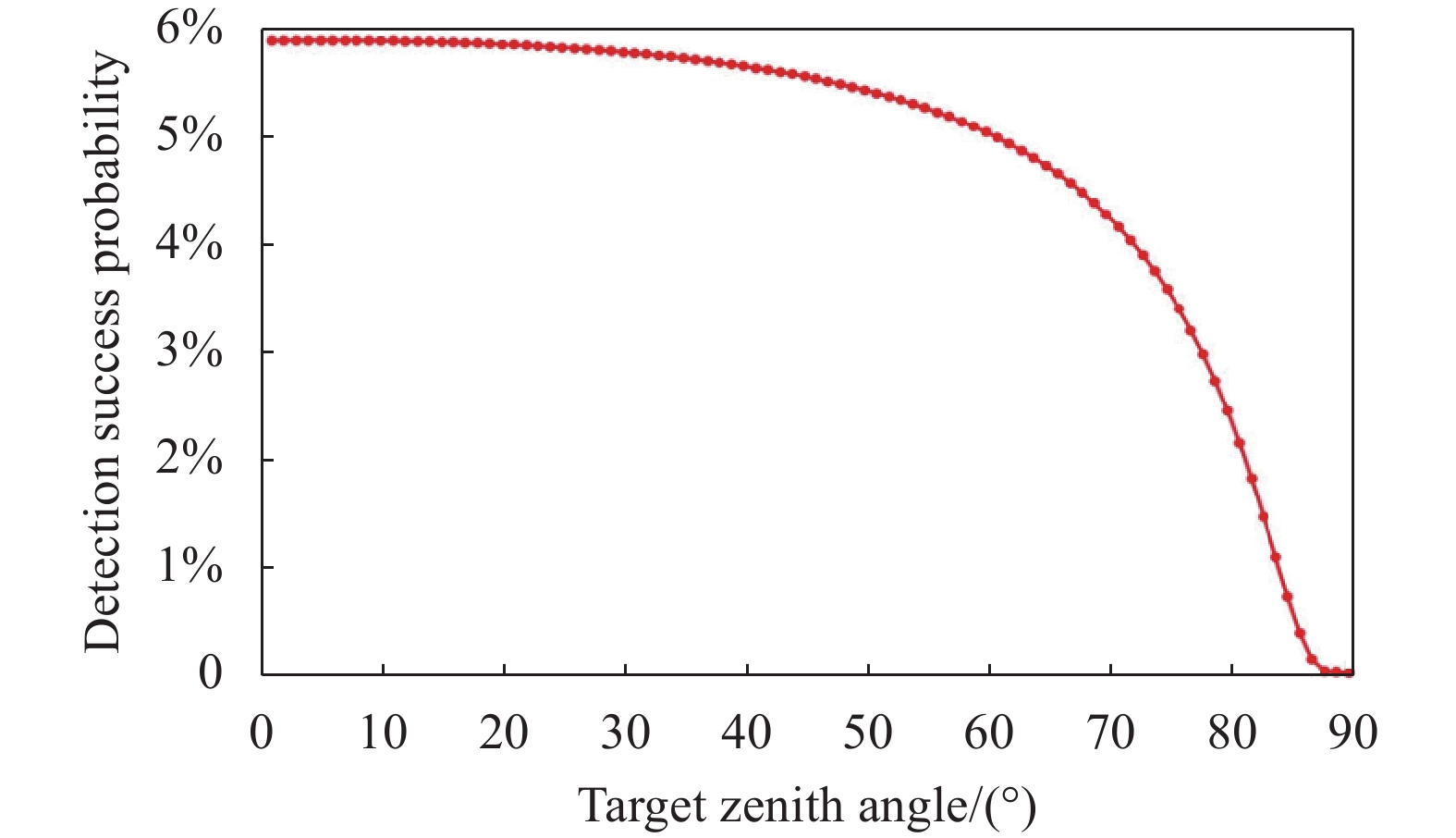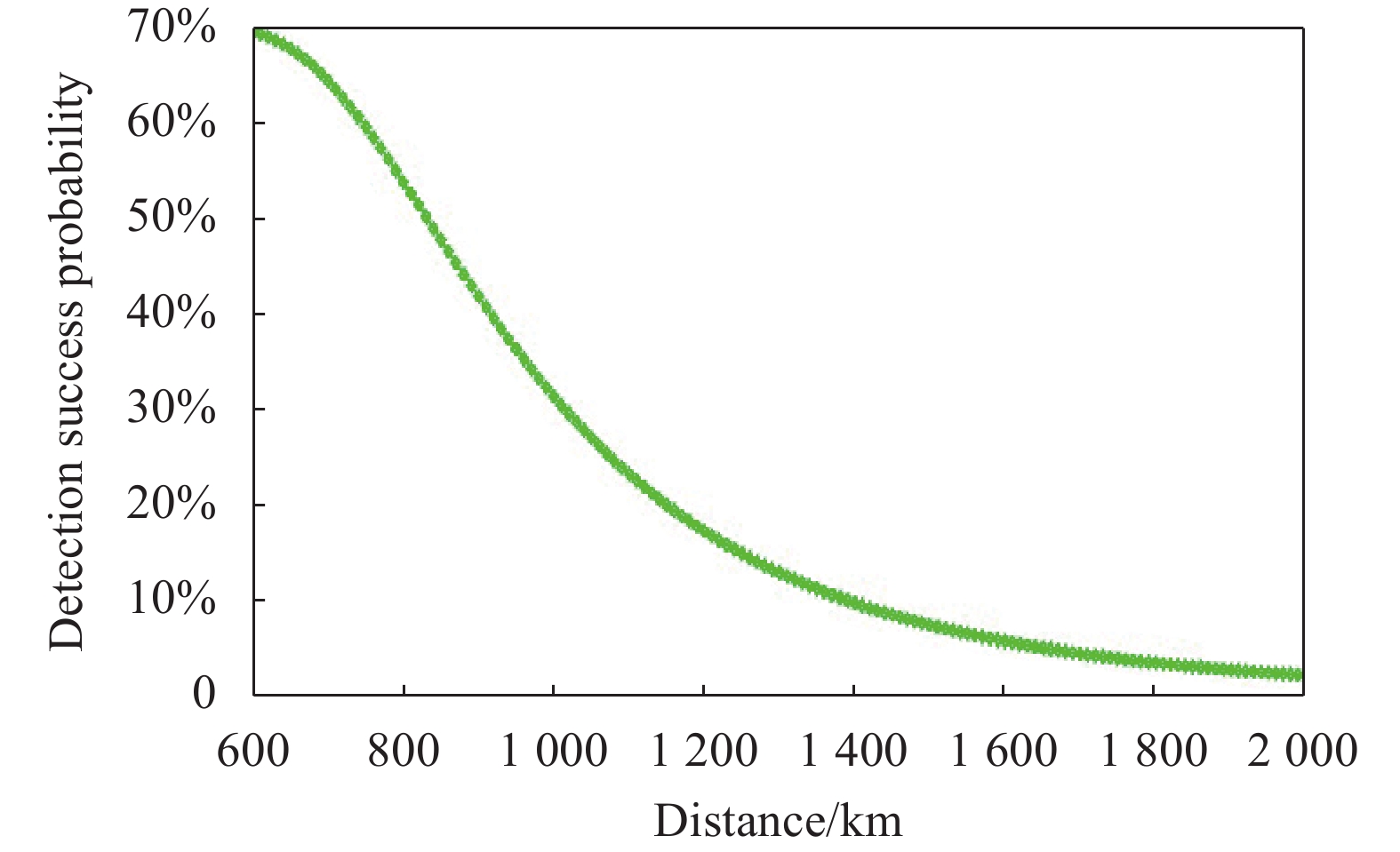-
近年来,随着全球空间技术的发展,特别像OneWeb星座、SpaceX、Telesat等商业卫星公司的崛起,人类向太空中发射的卫星急剧增多,导致围绕地球轨道运行的火箭体、失效卫星、飞行器及其相互之间碰撞产生的空间碎片进一步加剧,这严重限制了人们对宝贵的地球轨道资源的开发利用,空间碎片的存在已严重威胁到在轨航天器的安全和正常作业,清除空间碎片势在必行[1−4]。清除空间碎片的首要任务是对空间碎片进行精密定轨,而激光测距是目前精度最高的大地空间测量技术之一[5]。
自2002年澳大利亚EOS公司[1]首次报告成功实现了等效距离1000 km、尺寸小于10 cm的空间碎片激光测距(DLR)后,国内外相继开展了DLR研究,并成功获得了空间碎片的激光测距数据[4,6−10]。
现阶段,DLR面临的主要问题是观测弧段少和轨道预报精度差,两行根数(TLE)提供的近地圆轨道空间碎片24 h的预报精度普遍在百米甚至千米级[5],为解决该问题,人们开展了白天DLR[11]、一发多收DLR[12−13]、高频DLR[14−15]、近红外DLR[9,16]和超导纳米线DLR[10,17]等多种方法的组合与叠加。而太空中碎片数量惊人[7],所以相比于卫星激光测距(SLR),观测效率对DLR更为重要,为此,文中对空间碎片激光测距探测成功概率的影响因素展开了研究。
空间碎片激光测距成功概率是由目标信号探测概率和虚警率共同决定,通过理论模型建立、软件仿真的方式建立了DLR探测成功概率的归一化公式,并对其影响因素展开了仿真分析。该研究可以推广到其他观测台站,在实测中应用该公式并结合太阳方位信息和目标轨道预报信息,可以实时判断DLR的相对难易程度,特别是对致力于发展全自动DLR的台站,有助于观测效率的提升。
-
回波光子数是评估系统探测成功概率的重要参数之一。空间碎片激光测距与卫星激光测距原理相同,都是根据测量激光脉冲在测站与空间目标的往返时间来测量距离的,只是激光在卫星表面是全反射,在空间碎片表面是漫反射,假设回波光子反射方向为入射反方向的2π空间,则漫反射激光测距回波光电子数如下[18]:
式中:n0为系统接收到的单脉冲激光的平均回波光电子数;设激光波长λ=1064 nm;探测器量子效率ηq=0.2;普朗克常量h=6.63×10−34 J·s;真空中光速c=3×108 m/s;激光单脉冲能量Et=0.5 J;望远镜有效接收面积Ar=1.1 m2;As为空间碎片有效反射面积(用雷达散射截面积RCS替代);目标反射率ρ=0.18;θ为激光与碎片表面法线的夹角(假设激光正入射,则θ=0°,cosθ=1);激光束的发散角θt=10″;R为空间碎片轨道距离;T为单层大气透过率;发射系统传输效率ηt=0.8;接收系统传输效率ηr=0.6;大气衰减因子α=13 dB。
光子在探测器表面发生光电转换产生光电子服从泊松分布,按照泊松分布,平均信号光电子数为n0,产生m个光电子的概率记为:
则产生一个及以上信号光电子的概率为:
在白天DLR观测中,天空背景噪声比夜晚要大106倍,是影响测距成功概率的关键因素。探测器接收到的回波信号既包含了有效反射回波,也包含了目标黑体辐射噪声、后向散射噪声、探测器暗噪声和白天天空背景噪声等,对于白天DLR观测,噪声主要来源于天空背景噪声,其他噪声可忽略不计。白天天空背景噪声估算公式为[19]:
式中:NB为背景噪声在探测器光敏面上产生的平均光电子数速率;Nλ为天空背景辐照度;θr为接收视场角,取8″;q为干涉滤光片透过波段与接收器件的响应波段之比,取1/667。
设距离门有效期为L,则在距离门有效期内产生的噪声光电子数记为:
噪声光子在探测器光敏面上发生光电转换产生光电子同样服从泊松分布,则按照泊松分布,探测器的虚警率记为:
在进行DLR过程中,选用的是单光子探测器,信号被成功探测的前提是在距离门有效期内,信号光子触发探测器的同时噪声没有触发探测器,则系统信号探测成功概率可以表示为:
将公式(1)、(3)~(6)代入公式(7)中,可得系统的信号光子探测成功概率表达式为:
从公式(8)可以看出,在系统参数选定的情况下,目标的探测成功概率主要受天空背景辐照度和大气透过率影响,在目标探测成功概率估算中,要综合考虑天空背景辐照度(SBR)和大气透过率的影响。
文中将使用MODTRAN软件对目标探测成功概率公式中SBR和大气透过率的影响因素展开研究。MODTRAN是由LOWTRAN代码发展而来的,是美国空军地球物理实验室历经30多年研发的一个大气模拟软件,可计算指定路径上的大气透过率和辐照度,MODTRAN可计算的最小光谱分辨率达到了2 cm−1,其适用的波数范围是0~50 000 cm−1,该软件计算效率高,是国内外公认的应用最为广泛的辐射传输计算软件之一[20−21]。
-
地球大气是由多种气体和悬浮于其中的气溶胶粒子组成。在进行DLR过程中,激光穿过大气传输时,会与其中成分发生相互作用,包括吸收、散射、折射和反射等过程,其中,大气吸收和散射会使激光能量明显减弱,影响激光的传输距离,该指标主要体现在激光的大气透过率上。大气透过率具有波长选择性,因为大气中的气溶胶和水蒸气对不同波长激光进行选择性吸收。在晴朗天气情况下,大气透过率还受测站所在地的海拔高度和观测时目标的天顶角影响。在进行大气透过率仿真计算时,假设大气在垂直高度上由无穷多层浓度均匀的同心球组成,大气模型选择为夏季中纬度模型。为了比较不同海拔高度的大气透过率,选择长春站外场试验点和ILRS联合测站中海拔最高的Haleakala站,海拔高度分别为220.2 m和3056.3 m,分别计算了目标天顶角为0°时两地点的大气透过率。计算结果如图1所示。在以下MODTRAN仿真过程中,只考虑单一变量,其他参数都不变,此处只考虑海拔高度不同。
由图1可知,1064 nm波长光的大气透过率普遍高于532 nm波长光,这也是DLR系统通常选择1064 nm波长激光的原因之一;海拔3056.3 m处各波长光的大气透过率普遍高于220.2 m处,即海拔越高,相同波长光的大气透过率越高。
-
在海拔高度选定的情况下,大气透过率主要与观测时目标的天顶角$ \psi $有关。对于任意天顶角时的大气透过率T有[22]:
式中:$ {{T} _{\text{0}}} $为目标天顶角$ \psi {\text{ = }} $0°时的大气透过率,典型值为0.89;$ \psi $用角度制表示。
依该公式计算了大气透过率随目标天顶角的变化,并与MODTRAN仿真数值(海拔高度以220.0 m为例)进行了比较,结果如图2所示。

Figure 2. The calculated and simulated values of atmospheric transmittance of 1 064 nm wavelength laser vary with the target zenith angle
由图2可知,大气透过率的计算值与仿真值曲线基本重合,很好地验证了公式(9)和MODTRAN软件的有效性,且1064 nm波长激光的大气透过率随目标天顶角的增大而减小。
-
白天天空背景噪声主要与SBR(Sky Background Radiance)有关,而SBR主要受观测点海拔高度、太阳高度角和目标天顶角影响。
在进行卫星激光测距时,为了防止望远镜正对太阳,在观测高度和方位上设置了30°的“太阳直射”规避区,在近红外空间碎片激光测距的仿真过程中,同样设置了30°的规避区。分别计算了长春站外场试验点和Haleakala站两个海拔高度点的天顶位置SBR随光波长的变化。结果如图3所示。
由图3可知,1064 nm波长光的SBR比532 nm波长光低一个数量级;1064 nm波长光在两海拔点处基本相等,所以海拔对近红外光波段的SBR影响较小。
-
在海拔220.2 m的天顶位置,当太阳高度角从0°增加到90°时,仿真计算了1064 nm波长的SBR变化,结果如图4所示。
由图4可知,1064 nm波长光SBR随太阳高度角的增加而迅速增大,在太阳高度角增大到50°时,SBR趋于平缓。为了表示SBR和太阳高度角之间的关系,通过四阶多项式进行拟合,具体表示为:
曲线拟合残差标准差为0.27。其中,$ {{N} _{\lambda }}_{\text{S}}\left( 0 \right) $为1064 nm波长光在太阳高度角为0°(目标天顶角为0°)时的SBR,典型值为7.37×10−5 W/cm2 ·(sr·μm);太阳高度角$ \phi $,用角度表示。
-
目标天顶角从0°增加到85°时,仿真计算了1 064 nm波长光的SBR随目标天顶角的变化,结果见图5。
由图5可知,1064 nm波长光的SBR随目标天顶角增加而增大,在目标天顶角小于50°时,增速较平缓。为了表示SBR和目标天顶角之间的关系,通过四阶多项式进行拟合,具体表示为:
曲线拟合残差标准差为0.03。其中,$ {{N} _{\lambda}}_{\text{Z}}\left( {\text{0}} \right) $为1064 nm波长光在目标天顶角为0°(太阳高度角为0°)时的SBR,典型值为7.37×10−5 W/cm2·(sr·μm);目标天顶角$ \psi $,用角度表示。
在进行系统探测性能评估时,大气透过率主要影响系统的回波信号光子数,在其他条件不变的情况下,大气透过率越高,回波光子数越多,信号被探测到的概率越大;SBR主要影响系统的噪声水平,SBR越大,噪声越大,系统虚警率越高,信号的探测成功概率越低。
综合以上理论分析与仿真实验可以得出,1064 nm波长光的大气透过率普遍高于532 nm波长,特别是低仰角时;1064 nm波长光的SBR普遍低于532 nm波长光;海拔越高,大气透过率越高,越有助于提升系统探测能力;目标天顶角越小,大气透过率越高,SBR越低,越有助于提高回波信号的探测成功概率;太阳高度角越低,系统噪声越低,越有助于降低虚警率。
为了更直观讨论信号探测成功概率与各参数之间的关系,将公式(9)~(11)代入公式(8)中,则目标探测成功概率公式可以表示为:
代入系统参数,并以轨道距离为1000 km处半径为1 m的圆形空间碎片为例,分别研究太阳高度角、目标天顶角、目标轨道距离和目标大小对目标探测成功概率的影响。
-
在文献[23]中已经讨论了望远镜口径、激光单脉冲能量和重复频率对目标探测成功概率的影响,但以上系统参数均为固定参数,系统确定后,目标探测最大成功概率也随之确定。而在日常测距中,太阳高度角、目标天顶角、目标轨道距离和目标横截面积等参数的变化会对目标探测成功概率带来较大影响。基于公式(12)分别研究了目标探测成功概率与以上各参数之间的关系。
-
在白天DLR中,系统噪声主要来自天空背景噪声,而天空背景噪声的最主要影响因素是太阳高度角,其决定了噪声水平的大小。根据以上激光测距雷达方程和MODTRAN软件大气仿真结果建立了目标探测成功概率公式(12),依该公式仿真分析了碎片目标探测成功概率随太阳高度角的变化,如图6所示。
由图6可知,目标探测成功概率随太阳高度角的升高而减小,且基本成线性关系。即太阳高度角越高,系统噪声越大,虚警率越高,则目标探测成功概率越低。
-
目标天顶角对激光大气透过率和系统接收噪声水平有较大影响,进而影响到目标探测成功概率,根据公式(12)仿真分析了目标天顶角对目标探测成功概率的影响,如图7所示。
由图7可知,目标探测成功概率随目标天顶角增加而逐渐减小,当目标天顶角增加到70°时,目标探测成功概率开始急剧下降,所以在激光测距实际测量中,目标仰角低于20°时很难测到。
-
目标轨道距离是衡量系统探测能力的一项关键指标,通常情况下,系统建成后,系统的探测能力即已确定,但是在实际测量中,观测条件和观测目标的不同,会导致系统的实际探测能力有所改变。NASA轨道碎片计划办公室信息显示[7],空间碎片主要集中在低轨区域,即轨道距离低于2 000 km,而被其编目的碎片轨道高度多集中在600~1000 km范围内。所以文中选择轨道距离在600~2000 km之间的碎片,在不考虑望远镜跟踪速度与指向精度的情况下,根据公式(12)仿真分析了目标探测成功概率随目标轨道距离的变化情况,结果如图8所示。
由图8可知,目标探测成功概率随目标轨道距离的增加而迅速减小。这是因为回波光子数与目标轨道距离的四次方成反比,回波光子数骤降导致目标探测成功概率迅速减小。
-
目标横截面积和目标轨道距离一样,是衡量系统探测能力的关键指标。它往往和目标轨道距离密切相关,即目标轨道距离近,可探测到的碎片目标横截面积相对较小,目标轨道距离远,可探测到的碎片目标横截面积相对较大。在分析目标横截面积对目标探测成功概率的影响时,假设目标轨道距离为1 000 km,且横截面正对观测站,根据公式(12)仿真分析了目标横截面积对目标探测成功概率的影响,结果如图9所示。
由图9可知,目标探测成功概率随目标横截面积的增大而增大,近似成线性关系。
-
根据激光测距雷达方程和白天天空背景噪声估算公式,建立了目标探测成功概率公式,通过MODTRAN大气仿真软件,对大气透过率和天空背景噪声的影响因素(海拔、太阳高度角、目标天顶角等)进行了模拟仿真,得到仿真数据,又通过数据拟合方法,得到目标探测成功概率的归一化公式。通过该公式分别仿真分析了太阳高度角、目标天顶角、目标轨道距离和目标横截面积对目标探测成功概率的影响,得到以下结论:
1)目标探测成功概率随太阳高度角的升高而减小,且基本成线性关系。即太阳高度角越高,系统噪声越大,虚警率越高,目标探测成功概率越低;
2)目标探测成功概率随目标天顶角增加而逐渐减小,当目标天顶角增加到70°时,目标探测成功概率开始急剧下降,所以在激光测距实际测量中,目标仰角低于20°时很难测到;
3)目标探测成功概率随目标轨道距离的增加而迅速减小;
4)目标轨道距离固定情况下,目标探测成功概率随目标横截面积的增大而增大,近似成线性关系。
将该公式软件化,结合实时太阳方位信息和目标轨道预报信息,可以实时判断近红外空间碎片激光测距的相对难易程度,为观测人员提供一定的参考信息,可以在一定程度上提高观测效率,增加空间碎片的总观测弧段,有助于提高空间碎片的轨道精度。
现阶段,DLR正在成为人们的研究热点,世界范围内新建了很多DLR台站,以上判断DLR相对难易程度的方法可以推广到其他观测台站,特别是对致力于发展全自动DLR的台站,具有很大的应用价值。其中,欧洲就新建了很多低成本、小型化、智能化的可移动台站,旨在全面提升空间碎片的总观测弧段,对于全自动无人值守台站,该方法将有助于观测目标的选取,从而大大提高系统的观测效率。
The factors influencing the success probability of near-infrared space debris laser ranging detection
doi: 10.3788/IRLA20230695
- Received Date: 2023-12-14
- Rev Recd Date: 2024-01-05
- Publish Date: 2024-04-25
-
Key words:
- laser ranging /
- near-infrared space debris laser ranging /
- solar altitude angle /
- target zenith angle
Abstract:






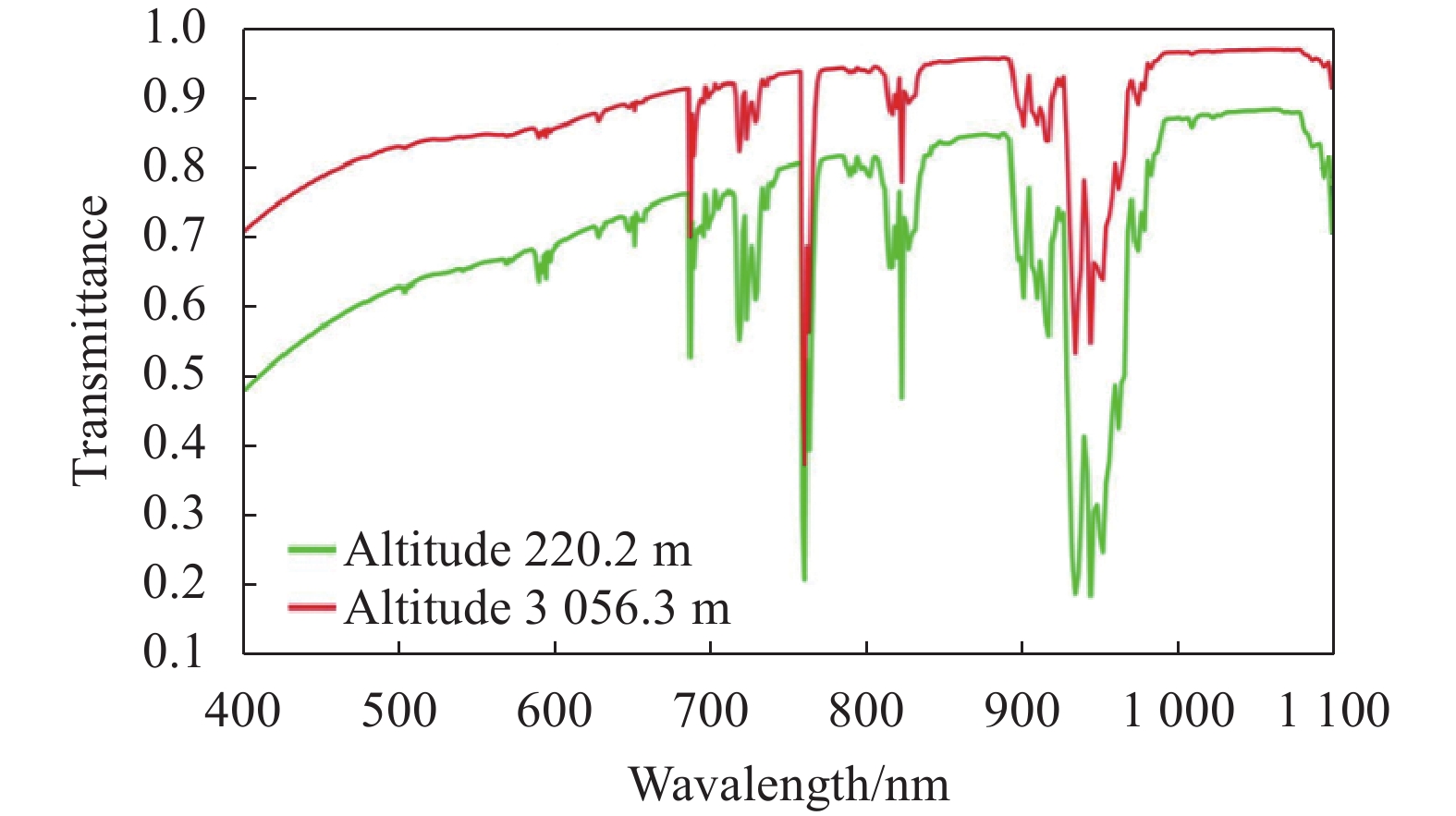



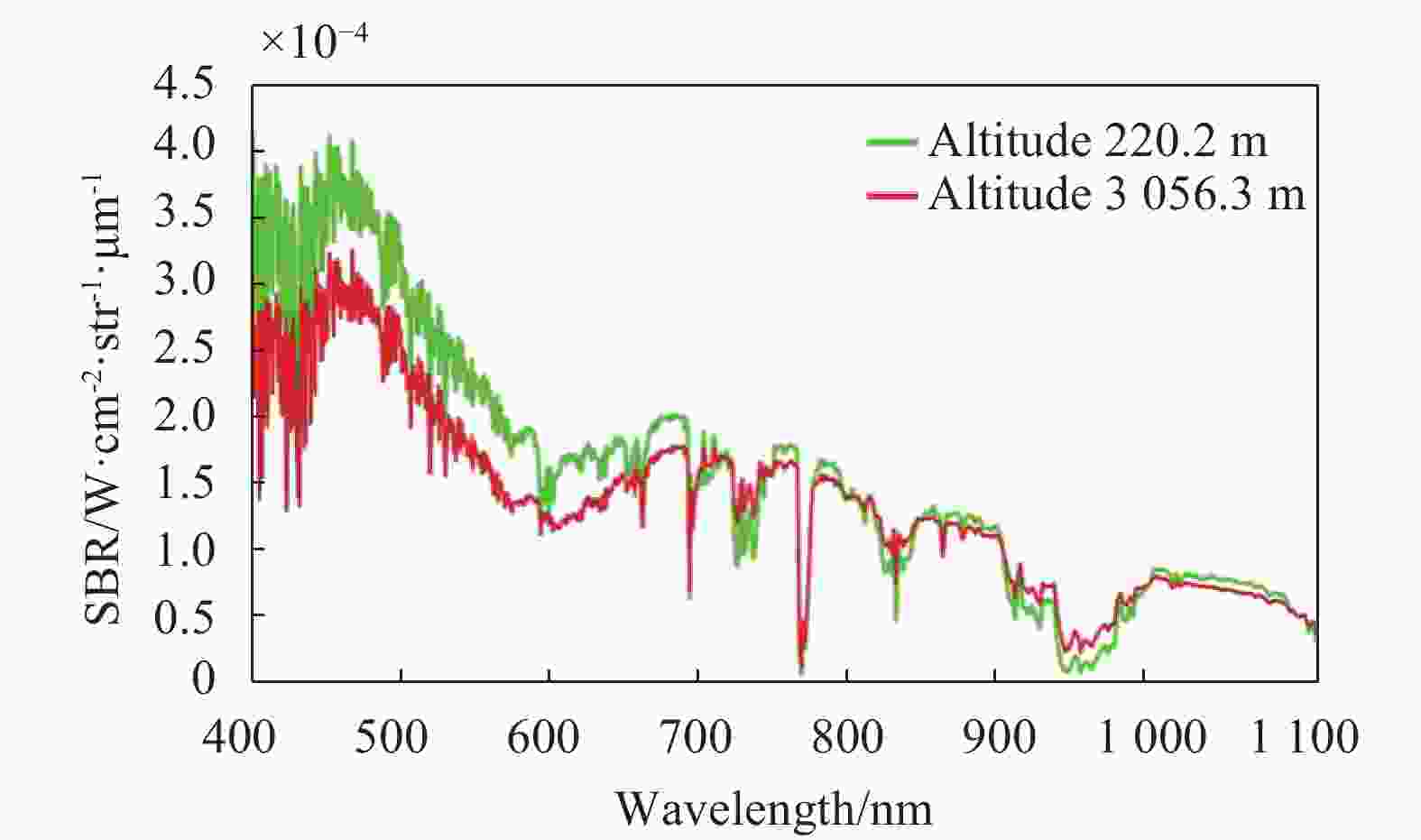




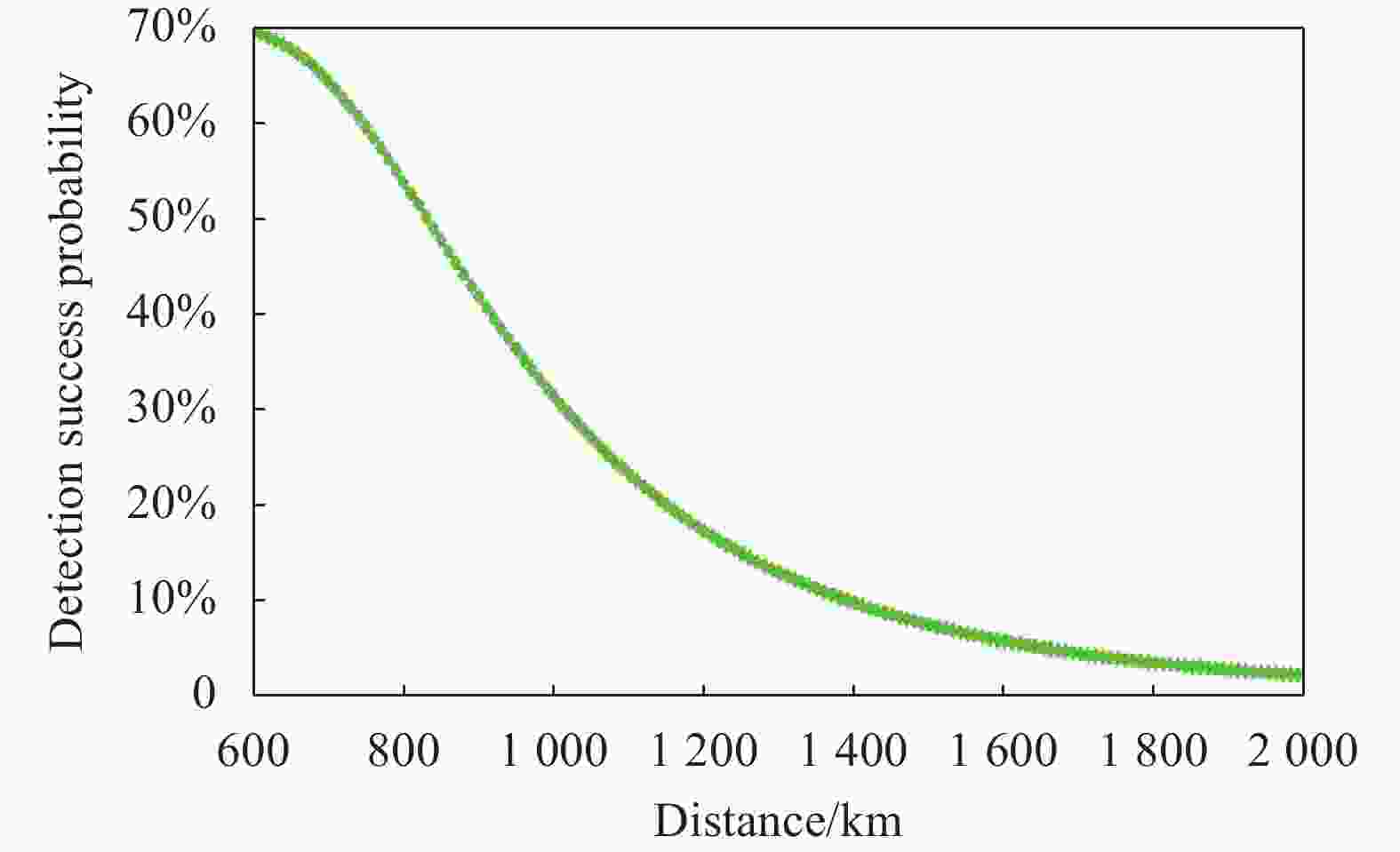


 DownLoad:
DownLoad:





